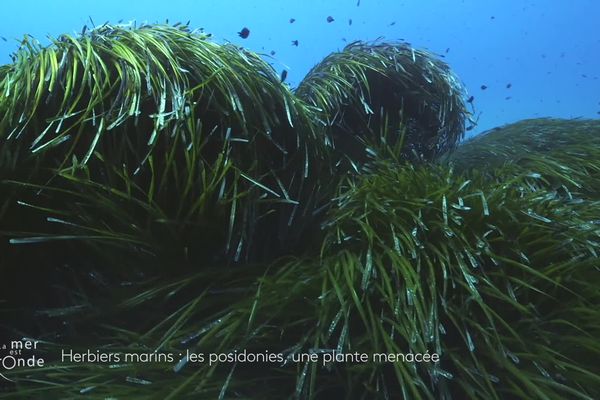Your new meeting “The sea is round” invites you to dive below the surface to discover the history of the underwater meadows lining the bottom of the oceans and most of the world’s seas. They provide multiple services beneficial to marine biodiversity. In Brittany, we talk about eelgrass, and in Corsica, it is posidonia which colonizes the seabed.
Eelgrass and Posidonia provide habitat and a food source for many marine species. These seagrass beds contribute to the stabilization of the seabed, the reduction of coastal erosion and the improvement of water quality. However, they are threatened by human activities. To protect them, we are looking for solutions along the Breton coast as in Corsica. A story to discover Saturday May 4 at 6:35 p.m. on ViaStella in a new episode of the magazine “The sea is round”.
How to reconcile pleasure and protection of Posidonia?
The bay of Sant’Amanza is a little paradise popular with boaters. Its crystal clear waters are part of the Bouches de Bonifacio nature reserve, the largest reserve in Metropolitan France. Between 0 and 40 meters, the Mediterranean seabed is covered with posidonia; deeper, they disappear. It is also at these depths that boat anchors are dropped. So the issue is there. How to reconcile pleasure and protection of this marine plant?
Wrongly called “algae”, Posidonia is a flowering plant, more than 100,000 years old. Little known but essential, for marine life, to fight against coastal erosion, to mitigate global warming. Seagrasses form underwater meadows, and on an equal surface area, these aquatic ecosystems capture three times more carbon than a forest.
For all these reasons, it has been protected by law since 1988. However, repeated anchoring has considerably weakened it, and only flagrant offense allows boaters who are disrespectful of nature and the laws to be punished. Between passive restoration and active restoration, initiatives to safeguard it are flourishing. Even if the best strategy remains preservation.
Donia, the waze of the sea
To preserve Posidonia, nothing could be simpler, you should not drop your anchor in them. But in practice it seems less obvious. Among novice or careless boaters, it still happens that Posidonia are mishandled. The problem is that a torn herbarium is lost and a scar will definitely take its place.
Because we no longer have the right not to know, we can get help from Donia. Donia is the short form for a general public mobile application, comparable to the “Waze of the sea”. The objective is to allow boaters, divers, fishermen and “all lovers of the sea” to drop anchor in a sandy area and not in a seagrass bed. Thus preserve sensitive marine ecosystems, and respect the law. As a reminder, Posidonia is a protected species under international, European and national regulations.
Donia was therefore designed because the seabed bears the marks of anchoring in seagrass beds. It was the divers from Andromeda Oceanology who highlighted this sad observation, and decided to get to the root of the problem.
The bigger the boat, the more serious the damage.
The pressure on posidonia is only partly due to small boating. Raising an anchor is not trivial, it can plow the bottom, and leave a gaping scar in the middle of the seagrass. The currents will widen these furrows, which will never close. The bigger the anchor, the more serious the damage. Since 2019, the Maritime Prefecture has prohibited the anchoring of yachts over 24 meters in certain protected areas such as the bay of Sant’Amanza.
The objective being to change the regulations for anchoring, and to regulate the arrival of these boats.
/regions/2024/04/26/controle-de-plaisancier-par-les-agents-du-parc-naturel-662b99c2929e0429785360.jpg)
Every summer, agents of the Corsica Regional Natural Park carry out checks at sea to verify compliance with the rules for mooring boats outside protected areas.
Every summer, agents of the Corsica Regional Natural Park carry out checks at sea to verify compliance with the rules for mooring boats outside protected areas. • © France 3 Corsica ViaStella
During the summer, controls become stricter. Natural Park agents collaborate with those of the semaphores, and check that the boats have dropped anchor outside the protected areas, in sand spots. If education remains essential with small boaters, zero tolerance is applied for large units where the captain is always a professional. Violators face penalties of one year in prison and a fine of €150,000.
Experimental project: regulating large-scale pleasure boating rather than banning it in protected areas.
The preservation of herbaria will have to involve the development of alternative solutions. Because for certain municipalities, like Bonifacio, welcoming super-yachts is a major economic issue. Sant’Amanza is a popular area for boaters, and boats over 24 meters can take advantage of 14 mooring points which are part of a pilot and experimental project. These are buoys attached to “eco-designed” boxes, that is to say supports resembling rocks, allowing biodiversity to develop quickly. The objective is to reduce the impact on the marine environment, and to integrate these temporary installations as best as possible. The locations chosen are sites already heavily impacted by anchoring.
/regions/2024/04/26/coffres-d-amarrage-662b9adde8d18256727682.jpg)
To allow yachts to moor even in protected areas like the bay of Sant’Amanza, specific boxes have been submerged. They enable the development of biodiversity.
To allow yachts to moor even in protected areas like the bay of Sant’Amanza, specific boxes have been submerged. They enable the development of biodiversity. • © France 3 Corsica ViaStella
And the project is paired with a second underwater garden experiment, led by the University of Corsica. Uprooted seagrasses are transplanted onto different supports, and we observe the growth or mortality rate of these convalescent posidonia. This “laboratory garden” is located just under the buoys where the mega yachts moor.
The project runs until the end of 2024, but the encouraging results could give rise to a waiver to extend the study and reception of the ships.
However, there is no need to wait for the results, we already know that the growth of the herbarium is extremely slow, only one to two centimeters per year. Rebuilding the uprooted posidonia forests cannot therefore be a short-term solution. “Passive” restoration, that is to say preservation, remains the best alternative.



